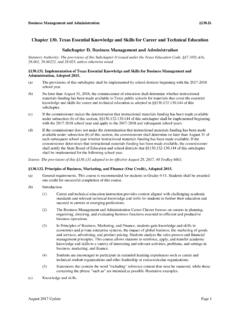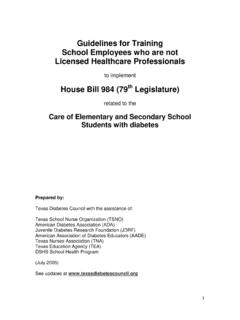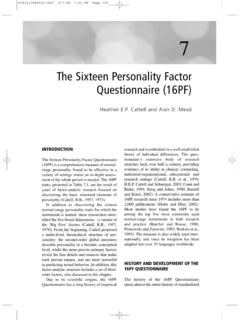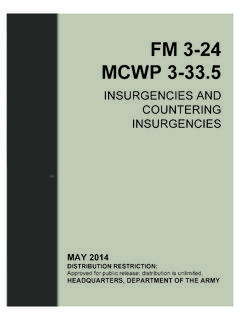Transcription of 2018 Dyslexia Handbook - ritter.tea.state.tx.us
1 THE. Dyslexia . Handbook . 2018 Update Procedures Concerning Dyslexia and Related Disorders TEXAS EDUCATION AGENCY AUSTIN, TEXAS. NOVEMBER 2018. THE Dyslexia Handbook . Procedures Concerning Dyslexia and Related Disorders 2018 Update 2018 by the Texas Education Agency Copyright Notice. The Materials are copyrighted and trademarked as the property of the Texas Education Agency (TEA) and may not be reproduced without the express written permission of TEA, except under the following conditions: 1) Texas public school districts, charter schools, and Education Service Centers may reproduce and use copies of the Materials and Related Materials for the districts' and schools' educational use without obtaining permission from TEA. 2) Residents of the state of Texas may reproduce and use copies of the Materials and Related Materials for individual personal use only, without obtaining written permission of TEA.
2 3) Any portion reproduced must be reproduced in its entirety and remain unedited, unaltered and unchanged in any way. 4) No monetary charge can be made for the reproduced materials or any document containing them;. however, a reasonable charge to cover only the cost of reproduction and distribution may be charged. Private entities or persons located in Texas that are not Texas public school districts, Texas Education Service Centers, or Texas charter schools or any entity, whether public or private, educational or non- educational, located outside the state of Texas MUST obtain written approval from TEA and will be required to enter into a license agreement that may involve the payment of a licensing fee or a royalty. For information contact: Office of Copyrights, Trademarks, License Agreements, and Royalties, Texas Education Agency, 1701 N.
3 Congress Ave., Austin, TX 78701-1494; phone 512-463-7004; email: i Table of Contents Chapters I. Definitions and Characteristics of Dyslexia .. 1. II. Screening .. 7. III. Procedures for the Evaluation and Identification of Students with Dyslexia .. 21. IV. Critical, Evidence-Based Components of Dyslexia Instruction .. 39. V. Dysgraphia .. 60. Figures Figure Considerations for Local Scheduling of Dyslexia Screening .. 10. Figure Criteria for English and Spanish Screening Instruments .. 12. Figure Student Behaviors Observed During Screening .. 13. Figure Sources and Examples of Screening Data .. 15. Figure Universal Screening and Data Review for Reading 17. Figure State and Federal Laws .. 24. Figure Sources and Examples of Cumulative 26.
4 Figure Additional Data Sources for English Learners .. 27. Figure Areas for Evaluation .. 30. Figure Dyslexia in Transparent and Opaque Orthographies .. 31. Figure Characteristics of Dyslexia in English and Spanish .. 31. Figure Questions to Determine the Identification of Dyslexia .. 32. Figure Pathways for the Identification and Provision of Instruction for Students with Dyslexia .. 35. Figure Minimum Training Requirements for Educators Providing Dyslexia Services .. 44. Figure Treatments Ineffective for Dyslexia .. 53. Figure Sources and Examples of Cumulative 62. Figure Areas for Evaluation .. 64. Figure Questions to Determine the Identification of 65. Figure Handwriting Hierarchy of Instruction .. 68. ii I. Definitions and Characteristics of Dyslexia The student who struggles with reading and spelling often puzzles teachers and parents.
5 The student displays ability to learn in the absence of print and receives the same classroom instruction that benefits most children; however, the student continues to struggle with some or all of the many facets of reading and spelling. This student may be a student with Dyslexia . Texas Education Code (TEC) defines Dyslexia and related disorders in the following way: Dyslexia means a disorder of constitutional origin manifested by a difficulty in learning to read, write, or spell, despite conventional instruction, adequate intelligence, and sociocultural opportunity. Related disorders include disorders similar to or related to Dyslexia , such as developmental auditory imperception, dysphasia, specific developmental Dyslexia , developmental dysgraphia, and developmental spelling disability.
6 TEC (d)(1)-(2) (1995). # The International Dyslexia Association defines Dyslexia in the following way: Dyslexia is a specific learning disability that is neurobiological in origin. It is characterized by difficulties with accurate and/or fluent word recognition and by poor spelling and decoding abilities. These difficulties typically result from a deficit in the phonological component of language that is often unexpected in relation to other cognitive abilities and the provision of effective classroom instruction. Secondary consequences may include problems in reading comprehension and reduced reading experience that can impede growth of vocabulary and background knowledge. Adopted by the International Dyslexia Association Board of Directors, November 12, 2002.
7 Students identified as having Dyslexia typically experience primary difficulties in phonological awareness, including phonemic awareness and manipulation, single-word reading, reading fluency, and spelling. Consequences may include difficulties in reading comprehension and/or written expression. These difficulties in phonological awareness are unexpected for the student's age and educational level and are not primarily the result of language difference factors. Additionally, there is often a family history of similar difficulties. The following are the primary reading/spelling characteristics of Dyslexia : Difficulty reading words in isolation Difficulty accurately decoding unfamiliar words Difficulty with oral reading (slow, inaccurate, or labored without prosody).
8 Difficulty spelling It is important to note that individuals demonstrate differences in degree of impairment and may not exhibit all the characteristics listed above. 1. The reading/spelling characteristics are most often associated with the following: Segmenting, blending, and manipulating sounds in words (phonemic awareness). Learning the names of letters and their associated sounds Holding information about sounds and words in memory (phonological memory). Rapidly recalling the names of familiar objects, colors, or letters of the alphabet (rapid naming). Consequences of Dyslexia may include the following: Variable difficulty with aspects of reading comprehension Variable difficulty with aspects of written language Limited vocabulary growth due to reduced reading experiences Sources for Characteristics and Consequences of Dyslexia Branum-Martin, L.
9 , Fletcher, J. M., & Stuebing, K. K. (2013). Classification and identification of reading and math disabilities: The special case of comorbidity. Journal of Learning Disabilities, 12, 906 915. Fletcher, J. M., Lyon, G. R., Fuchs, L. S., & Barnes, M. A. (2007). Learning disabilities: From identification to intervention. New York, NY: The Guilford Press. The International Dyslexia Association. (2018). Knowledge and practice standards for teachers of reading, (2nd ed.). Retrieved from Moats, L. C., & Dakin, K. E. (2008). Basic facts about Dyslexia and other reading problems. Baltimore, MD: The International Dyslexia Association. Connecting Research and Practice Research in understanding Dyslexia as a neurodevelopmental disorder is ongoing.
10 Future research will assist in learning more about the phonological awareness deficit and how this deficit interacts with other risk factors related to Dyslexia . Research is now also focusing on the developmental cause of neural abnormalities and how these predict treatment response. Pennington, B. F. (2009). Diagnosing learning disorders: A neuropsychological framework (2nd ed.). New York, NY: The Guilford Press. Peterson, R. L., & Pennington, B. F. (2012). Developmental Dyslexia . The Lancet, 379(9830), 1997 2007. Common Risk Factors Associated with Dyslexia If the following behaviors are unexpected for an individual's age, educational level, or cognitive abilities, they may be risk factors associated with Dyslexia . A student with Dyslexia usually exhibits several of these behaviors that persist over time and interfere with his/her learning.







